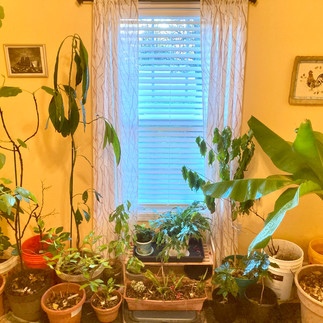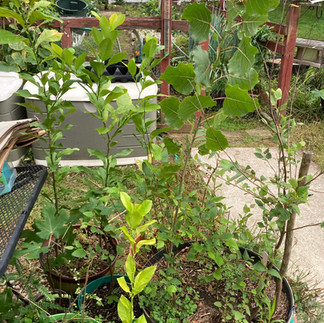Earth Day Every Day - Zach Kapple
- Harlem Valley Homestead
- Mar 25, 2024
- 4 min read
Updated: Apr 24, 2024
Howdy all & Spring tidings!

If I had to choose a favorite season, it would be a close tie between winter and spring. There is just nothing quite like the endless potential of winter as it leads into biological spring. I love the early risers like skunk cabbage and crocuses poking out, the tulips and other visible aspects of spring beginning to flourish. However, I’m most excited about the process behind it all, as trees begin to break dormancy.
I have never really celebrated Earth Day, though I do appreciate the initiative and the efforts made on this day each year. Trees hold a special place in my heart, and so I’m taking this opportunity to talk about them - my silent, enduring, and adaptable friends. It has been almost exactly a decade since I began intentionally planting and caring for trees, and that feels worth celebrating.
What began as a self-centered interest in fruiting trees, has since developed into a love, concern, and appreciation for trees at large. Over this decade, I’ve realized what incredible value trees offer to our food web and our water supply, how they hold our soils together and slowly change them for the better. What began as two ‘fig trees’ in plastic jugs (they were actually very old tomato plants I’d foolishly kept alive!), has now turned into a yearly exodus of hundreds of pounds of planters back outside and into the sun.
I’ve become an avid seed saver, and will make efforts to plant anything I’ve eaten, found, or saved. Year after year, seeds are planted, marked and imbued with a small amount of my excitement and hope before I leave them to fend for themselves. No longer do I fuss over my plants, because of what I have learned from caring for trees. And this technique - what Mark Shepard terms STUN (Sheer, Total, Utter Neglect) - will leave only the trees that can fare on their own in the conditions they have faced in a particular place in time. There are no sprays or neem oil concoctions applied. There is only the garden fence to protect the overwintering trees from deer browse, and the occasional watering in summer when droughts persist. All in all, what remain are arguably my best suited trees for this area, and the conditions we experience here year to year.
Some of Zachary's tree collection
I had the unfathomable opportunity to meet Jane Goodall about a decade ago. I had never been so starstruck, and was so nervous that all I could remember amidst all the specifics covered was how important it was to plant seeds and maintain hope about the future. In the weeks that followed, I began to compost just to try it, to reduce and reclaim the products and packaging I had been using and abusing so mindlessly, and most importantly - I started planting seeds from any fruit or vegetable I’d eaten.
Along the way, I’ve been lucky to have many conversations about this work. Amidst the surprises, I’ve garnered one usual response when I refer to my various types of apple, lemon, orange, and pear trees planted from seed - “those will never bear fruit, you know.” I think it’s difficult to remain unsure about something, particularly over a decade or more in a practice. People are attracted to expertise, and so those who care for trees begin, like many, to try their hand at acquiring knowledge. We collect parts and bits, and try to fit them together as best we can. However, sometimes we are mistaken.
It took me the better part of a decade to deduce what Dr. Goodall really meant by the importance of planting seeds - that just because you can plant a cutting or otherwise clone a plant, does not mean you necessarily should. When we clone, we reduce genetic variability in the interest of obtaining the fruit we desire. But when we plant seeds from a plant that reproduces sexually, we give new, unseen genetic variants the opportunity to thrive, and perhaps surprise us!
To cite one specific example: ‘everyone knows’ you’ll never get apples worth eating by planting apple seeds. Why, then, do apples have seeds? How did the predecessors to the apple propagate and succeed themselves generation after then next without human intervention? How did the many varieties we know and love come to be? They were wonderful, random, unintended consequences of sexual reproduction in plants. In my mind, the only way to do a truly delicious fruit justice is to plant the seeds and see what happens next. The fruit was never really intended for us to eat, as much as it was bait to get us to plant the progeny for free! It may take time to find out whether you’ve stumbled upon the one-in-a-million apple variety that will change the game, but as the random survivors you’ve planted succeed and thrive, you can rest assured that the genetic lineage of the remaining plants are current and suited to conditions.
I may never stumble upon the next industry-leading variety of apple or pear or fig. The point is that that was never the point at all. I’ve learned so much about the world as it truly is from taking the time to do my food (and their progeny) some justice.
Is this effort of mine sustainable? No, certainly not with respect to the haul of planters in for winter and out for spring. Yet, when my partner and I land where we’re going to stay, we will have hundreds of trees ready for transplant, suited to this particular place and climate.
A happy, hopeful Earth Day,
-Zachary







